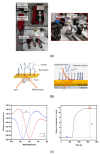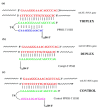Fast and Accurate Pneumocystis Pneumonia Diagnosis in Human Samples Using a Label-Free Plasmonic Biosensor
- PMID: 32604931
- PMCID: PMC7353103
- DOI: 10.3390/nano10061246
Fast and Accurate Pneumocystis Pneumonia Diagnosis in Human Samples Using a Label-Free Plasmonic Biosensor
Abstract
Pneumocystis jirovecii is a fungus responsible for human Pneumocystis pneumonia, one of the most severe infections encountered in immunodepressed individuals. The diagnosis of Pneumocystis pneumonia continues to be challenging due to the absence of specific symptoms in infected patients. Moreover, the standard diagnostic method employed for its diagnosis involves mainly PCR-based techniques, which besides being highly specific and sensitive, require specialized personnel and equipment and are time-consuming. Our aim is to demonstrate an optical biosensor methodology based on surface plasmon resonance to perform such diagnostics in an efficient and decentralized scheme. The biosensor methodology employs poly-purine reverse-Hoogsteen hairpin probes for the detection of the mitochondrial large subunit ribosomal RNA (mtLSU rRNA) gene, related to P. jirovecii detection. The biosensor device performs a real-time and label-free identification of the mtLSU rRNA gene with excellent selectivity and reproducibility, achieving limits of detection of around 2.11 nM. A preliminary evaluation of clinical samples showed rapid, label-free and specific identification of P. jirovecii in human lung fluids such as bronchoalveolar lavages or nasopharyngeal aspirates. These results offer a door for the future deployment of a sensitive diagnostic tool for fast, direct and selective detection of Pneumocystis pneumonia disease.
Keywords: DNA capture; Pneumocystis jirovecii; Surface Plasmon Resonance; clinical diagnosis; optical biosensor; triplex.
Conflict of interest statement
The authors declare no conflicts of interest.
Figures










Similar articles
-
Triplex Hybridization-Based Nanosystem for the Rapid Screening of Pneumocystis Pneumonia in Clinical Samples.J Fungi (Basel). 2020 Nov 17;6(4):292. doi: 10.3390/jof6040292. J Fungi (Basel). 2020. PMID: 33213011 Free PMC article.
-
Use of different primer directed sequence amplification by polymerase chain reaction for identification of Pneumocystis jirovecii in clinical samples.Indian J Chest Dis Allied Sci. 2008 Oct-Dec;50(4):321-7. Indian J Chest Dis Allied Sci. 2008. PMID: 19035050 Clinical Trial.
-
Utility of adding Pneumocystis jirovecii DNA detection in nasopharyngeal aspirates in immunocompromised adult patients with febrile pneumonia.Med Mycol. 2015 Apr;53(3):241-7. doi: 10.1093/mmy/myu087. Epub 2014 Dec 30. Med Mycol. 2015. PMID: 25550391 Free PMC article.
-
Molecular diagnosis of Pneumocystis pneumonia.FEMS Immunol Med Microbiol. 2005 Sep 1;45(3):405-10. doi: 10.1016/j.femsim.2005.06.006. FEMS Immunol Med Microbiol. 2005. PMID: 16061360 Review.
-
Pneumocystis jirovecii detection in asymptomatic patients: what does its natural history tell us?F1000Res. 2017 May 23;6:739. doi: 10.12688/f1000research.10619.1. eCollection 2017. F1000Res. 2017. PMID: 28649366 Free PMC article. Review.
Cited by
-
Tumor-Induced Inflammatory Cytokines and the Emerging Diagnostic Devices for Cancer Detection and Prognosis.Front Oncol. 2021 Jul 7;11:692142. doi: 10.3389/fonc.2021.692142. eCollection 2021. Front Oncol. 2021. PMID: 34307156 Free PMC article. Review.
-
Development and Evaluation of Rapid and Accurate CRISPR/Cas13-Based RNA Diagnostics for Pneumocystis jirovecii Pneumonia.Front Cell Infect Microbiol. 2022 Jun 15;12:904485. doi: 10.3389/fcimb.2022.904485. eCollection 2022. Front Cell Infect Microbiol. 2022. PMID: 35782118 Free PMC article.
-
Biomimetic nanoplasmonic sensor for rapid evaluation of neutralizing SARS-CoV-2 monoclonal antibodies as antiviral therapy.Biosens Bioelectron. 2023 Apr 15;226:115137. doi: 10.1016/j.bios.2023.115137. Epub 2023 Feb 8. Biosens Bioelectron. 2023. PMID: 36796306 Free PMC article.
-
Sustainable Integration of Nanobiosensors in Biomedical and Civil Engineering: A Comprehensive Review.ACS Omega. 2025 Jun 10;10(24):25120-25157. doi: 10.1021/acsomega.5c00852. eCollection 2025 Jun 24. ACS Omega. 2025. PMID: 40584327 Free PMC article. Review.
-
Detection of SARS-CoV-2 Virus by Triplex Enhanced Nucleic Acid Detection Assay (TENADA).Int J Mol Sci. 2022 Dec 3;23(23):15258. doi: 10.3390/ijms232315258. Int J Mol Sci. 2022. PMID: 36499587 Free PMC article.
References
-
- Wang H.W., Lin C.C., Kuo C.F., Liu C.P., Lee C.M. Mortality predictors of Pneumocystis jirovecii pneumonia in human immunodeficiency virus-infected patients at presentation: Experience in a tertiary care hospital of northern Taiwan. J. Microbiol. Immunol. Infect. 2011;44:274–281. doi: 10.1016/j.jmii.2010.08.006. - DOI - PubMed
Grants and funding
- SEV-2017-0706/Agencia Estatal de Investigación
- BES-2017-080527/Agencia Estatal de Investigación
- 2016-78515-R/Agencia Estatal de Investigación
- CYTED 212RT0450/Red Iberoamericana sobre Pneumocystosis in the framework of The Ibero-American Programme for Science, Technology and Development
- CTQ2017-84415-R/Ministerio de Ciencia e Innovación

